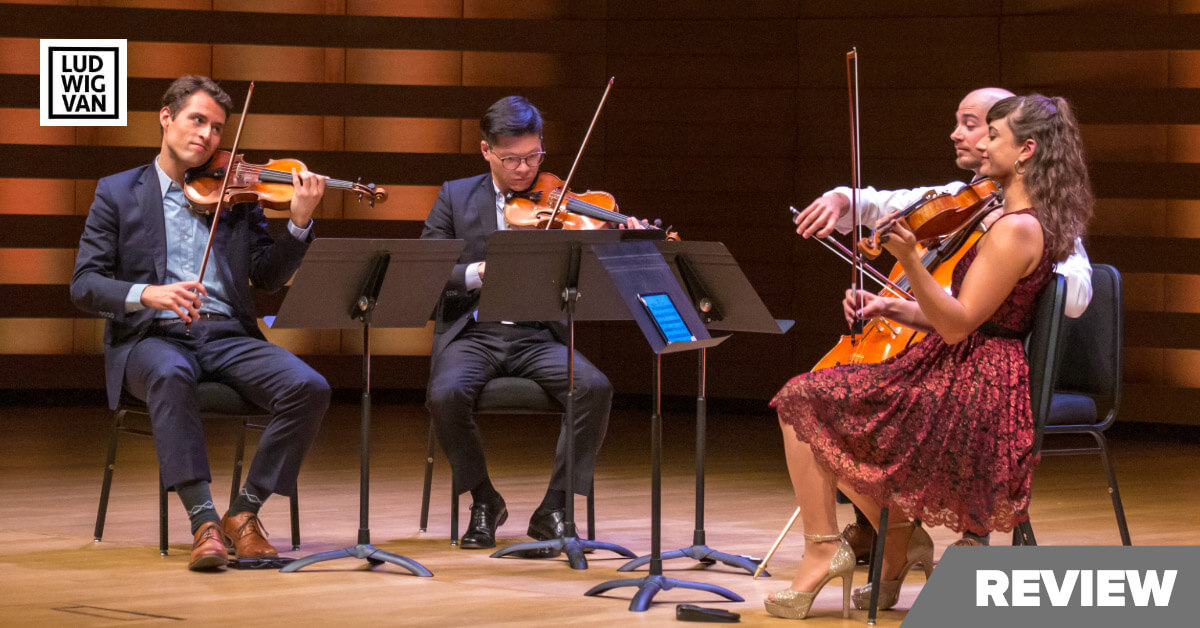
Toronto Summer Music: Dover Quartet at Koerner Hall. July 17, 2019.
After sweeping an array of prizes at the Banff Competition in 2013, the Dover Quartet has been making life difficult for critics with playing that pretty much defies criticism. The Americans were at it again Wednesday in Koerner Hall under the auspices of Toronto Summer Music.
Well, I guess I have to try.
If not exactly a reservation, one interesting question the concert raised is whether Bartók’s famously thorny Third String Quartet should sound so polished. Usually, the folksy theme played in octaves by the second violin and viola near the end of the Prima parte (as Bartók called it) is a lyrical refuge. On this occasion, it was more subtly woven into a fabric of sonorities that included special effects (including sul ponticello and col legno bow work) that seemed less fiercely experimental than alluringly impressionistic.
Might I go so far as to say that the dissonances scanned as consonances? That is how well the Dover texture is tuned and balanced. Of course, the players have a right to their view of the 1926 score as more a matter of sound than fury, and I have a right to appreciate it. The fugue, unsurprisingly, was a marvel of clarity, even at pianissimo.
Before this 15-minute masterpiece, we heard Britten’s more approachable but also more elusive String Quartet No. 1 of 1941. I am not sure the opening bars, pitting high-wire violins and viola against a low-plucking cello, were as otherworldly as they could have been, but there was still much magic in the opening movement. The pulses of the following scherzo had harmonic as well as rhythmic character. First violin Joel Link and viola Milena Pajaro-van de Stadt contributed long-lined solos to the nocturnal Andante calmo movement. The scurries of the finale left us wondering, quite appropriately, about the central message of this intriguing piece.
The big item after intermission was Dvořák’s Quartet in F Major “American.” Allow me the grumpy observation that this composer wrote at least 13 other string quartets. TSM would not have lost too many customers by programming one of these.
That said, the Dover performance was very fine. Pajaro-van de Stadt started the proceedings with a warm and soulful sound; the sweet second theme was taken slowly, possibly in defiance of Dvořák’s marking, but with ravishing effect. Cellist Camden Shaw (who offered some spoken program notes before the Bartók) played with disarming purity in the Lento. The lively finale, with a pointillistic accompaniment, illustrated the Dover knack of sounding simultaneously robust and refined.
There were many cheers from a crowd that probably included a few TSM Academy fellows. An encore followed, Duke Ellington’s In a Sentimental Mood, in an arrangement that gave welcome exposure to second violin Bryan Lee.
You can hear the Dovers, or at least three of them, on Friday evening in Walter Hall with Charles Richard-Hamelin in Brahms’s Piano Quartet in G Minor Op. 25.
LUDWIG VAN TORONTO
Want more updates on classical music and opera news and reviews? Follow us on Facebook, Instagram, or Twitter for all the latest.



